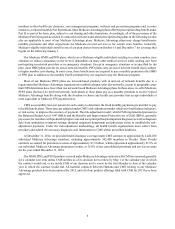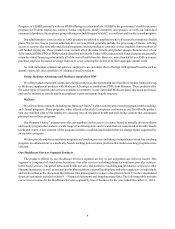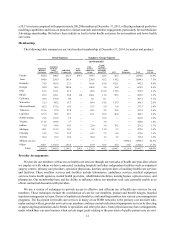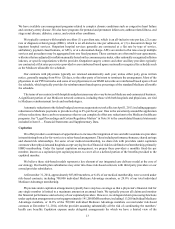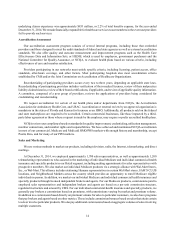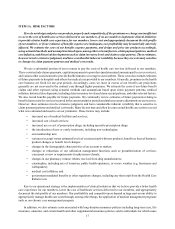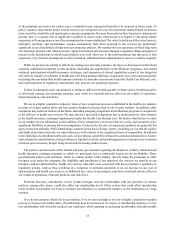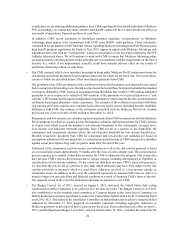Humana 2014 Annual Report Download - page 22
Download and view the complete annual report
Please find page 22 of the 2014 Humana annual report below. You can navigate through the pages in the report by either clicking on the pages listed below, or by using the keyword search tool below to find specific information within the annual report.14
underlying claims experience was approximately $833 million, or 2.2% of total benefits expense, for the year ended
December 31, 2014. We remain financially responsible for health care services to our members in the event our providers
fail to provide such services.
Accreditation Assessment
Our accreditation assessment program consists of several internal programs, including those that credential
providers and those designed to meet the audit standards of federal and state agencies as well as external accreditation
standards. We also offer quality and outcome measurement and improvement programs such as the Health Care
Effectiveness Data and Information Sets, or HEDIS, which is used by employers, government purchasers and the
National Committee for Quality Assurance, or NCQA, to evaluate health plans based on various criteria, including
effectiveness of care and member satisfaction.
Providers participating in our networks must satisfy specific criteria, including licensing, patient access, office
standards, after-hours coverage, and other factors. Most participating hospitals also meet accreditation criteria
established by CMS and/or the Joint Commission on Accreditation of Healthcare Organizations.
Recredentialing of participating providers occurs every two to three years, depending on applicable state laws.
Recredentialing of participating providers includes verification of their medical licenses, review of their malpractice
liability claims histories, review of their board certifications, if applicable, and review of applicable quality information.
A committee, composed of a peer group of providers, reviews the applications of providers being considered for
credentialing and recredentialing.
We request accreditation for certain of our health plans and/or departments from NCQA, the Accreditation
Association for Ambulatory Health Care, and URAC. Accreditation or external review by an approved organization is
mandatory in the states of Florida and Kansas for licensure as an HMO. Additionally, all products sold on the federal
and state marketplaces are required to be accredited. Certain commercial businesses, like those impacted by a third-
party labor agreement or those where a request is made by the employer, may require or prefer accredited health plans.
NCQA reviews our compliance based on standards for quality improvement, credentialing, utilization management,
member connections, and member rights and responsibilities. We have achieved and maintained NCQA accreditation
in most of our commercial, Medicare and Medicaid HMO/POS markets with enough history and membership, except
Puerto Rico, and for many of our PPO markets.
Sales and Marketing
We use various methods to market our products, including television, radio, the Internet, telemarketing, and direct
mailings.
At December 31, 2014, we employed approximately 1,700 sales representatives, as well as approximately 1,200
telemarketing representatives who assisted in the marketing of individual Medicare and individual commercial health
insurance and specialty products in our Retail segment, including making appointments for sales representatives with
prospective members. We also market our individual Medicare products via a strategic alliance with Wal-Mart Stores,
Inc., or Wal-Mart. This alliance includes stationing Humana representatives in certain Wal-Mart stores, SAM’S CLUB
locations, and Neighborhood Markets across the country which provides an opportunity to enroll Medicare eligible
individuals in person. In addition, we market our individual Medicare and individual commercial health insurance and
specialty products through licensed independent brokers and agents. For our Medicare products, commissions paid to
employed sales representatives and independent brokers and agents are based on a per unit commission structure,
regulated in structure and amount by CMS. For our individual commercial health insurance and specialty products, we
generally pay brokers a commission based on premiums, with commissions varying by market and premium volume.
In addition to a commission based directly on premium volume for sales to particular customers, we also have programs
that pay brokers and agents based on other metrics. These include commission bonuses based on sales that attain certain
levels or involve particular products. We also pay additional commissions based on aggregate volumes of sales involving
multiple customers.




